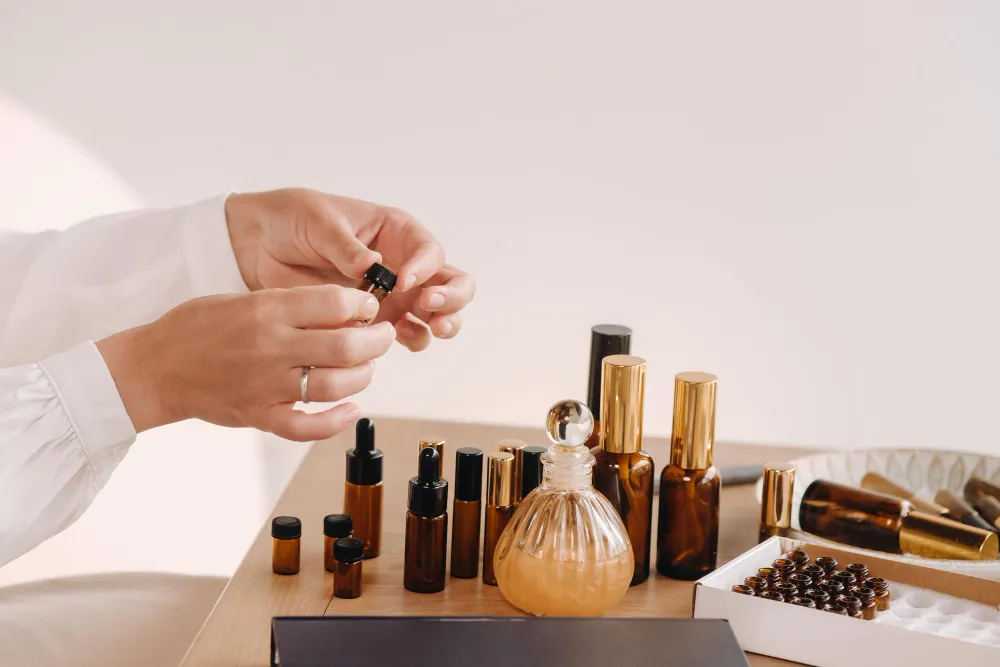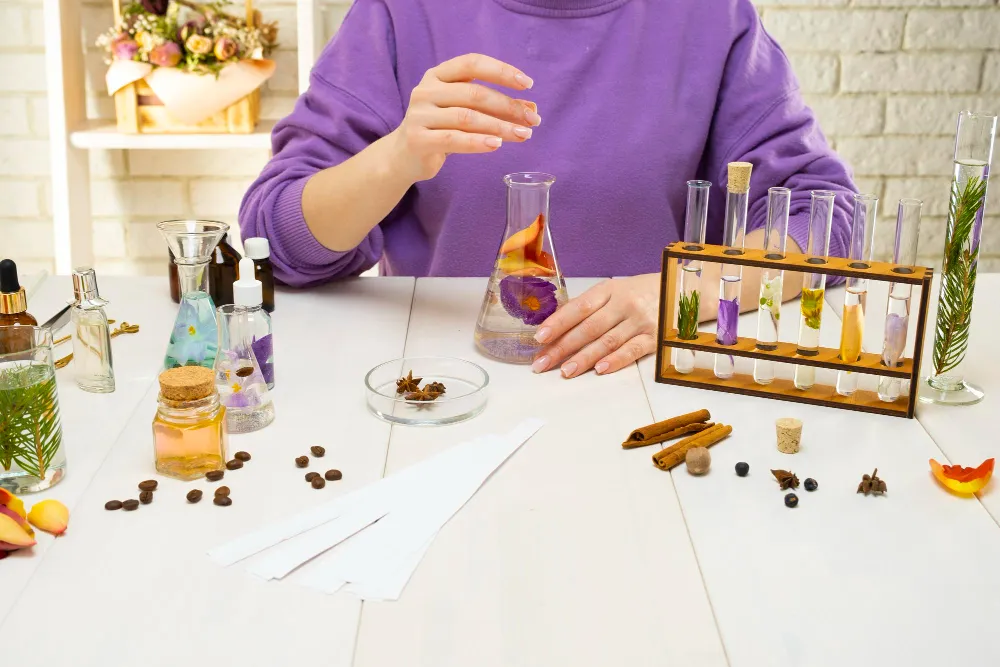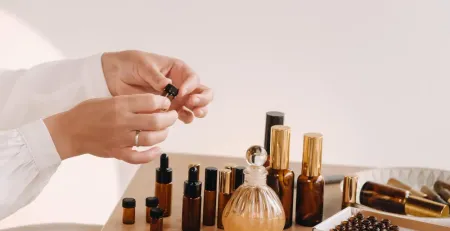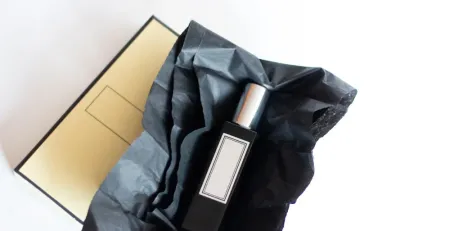Single Post
- Home
- Single Post
Alchemy of Aromas: The Intricate Process of Perfume Making
What is Behind Perfumes?
Behind every bottle of perfume lies a complex blend of art, science, and a deep understanding of human experience. Perfumes captivate the senses, evoke memories, and express individuality. The creation of a fragrance is a meticulous process that marries natural and synthetic ingredients in perfect harmony, resulting in a scent that can transport the wearer to different places, times, and emotions.
A Brief History of Perfumery
The origins of perfumery date back to ancient civilizations such as the Egyptians, who used scented ointments for religious ceremonies and personal enjoyment. The art of making perfumes spread through Greece, Rome, and the Islamic world, with each culture adding its own techniques and preferences to the craft. In the 14th century, the practice of perfumery blossomed in Europe, particularly in France, leading to the development of modern perfumery as we know it today. This rich history showcases the evolution of fragrance from simple scented oils to complex compositions that are an integral part of personal adornment.

The Basic Components of a Fragrance
Understanding the structure of a fragrance is essential to appreciating the depth and complexity behind each scent. A perfume is typically composed of three main layers known as notes:
- Top Notes: These are the scents that are immediately perceivable upon application of the perfume. Top notes are usually light, fresh, and invigorating, designed to make a strong first impression. Common top notes include citrus (lemon, orange zest), light fruits (grapefruit, berries), and herbs (lavender, sage).
- Middle Notes: Also known as the heart notes, these represent the core of the fragrance. Middle notes emerge just after the top notes dissipate and are usually more mellow and rounded. They are considered the heart of the perfume, contributing to the main body of the scent. Floral (rose, jasmine), spice (cinnamon, nutmeg), and fruit (apple, cherry) scents are popular middle notes.
- Base Notes: These notes are the foundation of the fragrance and give it depth. Base notes linger the longest on the skin and blend with the middle notes to create the full body of the perfume. They are typically rich and deep, with scents like musk, vanilla, amber, and sandalwood being common choices.
These components are blended in precise ratios to create the harmonious scent profile that characterizes each unique fragrance. The artistry of perfumery lies in the perfumer’s ability to balance these notes, ensuring that they unfold beautifully over time on the skin, providing a dynamic and evolving scent experience.
The journey from raw ingredients to the final fragrance is a testament to the meticulous craft behind the creation of perfumes. Each scent encapsulates a world of history, innovation, and artistic expression, making perfumery a fascinating blend of tradition and modernity. At MC Grand Shop, we celebrate this intricate process, offering fragrances that honor the legacy and expertise of the perfume industry.

Sourcing the Ingredients
The creation of a perfume begins with the careful selection and sourcing of ingredients, a process that is as much about art as it is about science. Perfumers, or “noses,” must have a deep understanding of the characteristics of each potential ingredient, from its scent profile to how it interacts with other aromas. The ingredients used in perfumery can be broadly categorized into natural ingredients and synthetic components, each playing a crucial role in the fragrance’s final composition.
Natural Ingredients
Natural ingredients come from the earth and include flowers, fruits, woods, and resins. These are harvested from around the world, with certain locations known for their specific produce—such as jasmine from Grasse, France, or sandalwood from India. The quality of these natural ingredients depends on numerous factors, including the climate, soil conditions, and the time of harvest, making the sourcing process a meticulous one that often involves strong relationships with growers and suppliers to ensure the best raw materials are obtained.
Synthetic Components
Synthetic components, on the other hand, are created in laboratories. These ingredients can either mimic natural scents or offer entirely new fragrances that don’t exist in the natural world. Synthetics play a vital role in perfumery by providing consistency, enhancing the longevity of a fragrance, and allowing for creative freedom in scent design. They also make perfumery more sustainable, as they can reduce the demand for rare or over harvested natural ingredients.
How are the ingredients selected?
The selection of ingredients is a deliberate and thoughtful process that begins with the perfumer’s vision for the fragrance. This vision can be inspired by a wide range of sources, including emotions, memories, landscapes, or even abstract concepts. Perfumers must consider the evaporation rate, intensity, and how each ingredient will interact within the fragrance’s overall composition.
- Evaporation Rate: Ingredients are chosen based on how quickly they evaporate, which determines their placement as top, middle, or base notes within the fragrance structure.
- Intensity and Character: The intensity and character of an ingredient influence how it will be perceived in the final scent, guiding the perfumer in creating a balanced and harmonious fragrance.
- Interactions: Understanding how different ingredients interact with one another is crucial. Some ingredients may enhance each other’s qualities, while others might overshadow or clash.
The Journey of Scent Ingredients
After selection, the journey of scent ingredients from raw materials to the essence used in perfumery involves several processes. The most common methods of extracting scents from natural ingredients include distillation, expression, and solvent extraction, each suitable for different types of materials.
- Distillation: This is one of the oldest and most common methods, where steam is used to extract the essential oils from plant materials. The steam carrying the oils is then cooled, condensing back into a liquid where the oil separates from the water.
- Expression: Used primarily for citrus peels, expression involves mechanically pressing the plant material to release the essential oils. It’s a method that doesn’t involve heat, making it ideal for preserving the integrity of the delicate oils.
- Solvent Extraction: This method uses solvents to dissolve the aromatic compounds out of the plant material. The solution then undergoes a process to remove the solvent, leaving behind the pure fragrance oil. Solvent extraction is often used for fragile materials that cannot withstand the heat of distillation.

Each of these processes is chosen based on how well they can capture the essence of the ingredient, ensuring that the integrity and purity of the scent are maintained. This journey from raw material to concentrated fragrance oil is a testament to the complexity and beauty of perfume making, blending tradition with technology to create scents that enchant and inspire. At MC Grand Shop, we honor this intricate process, offering fragrances that represent the pinnacle of craftsmanship and olfactory art.
The Perfume Manufacturing Process
The journey of creating a perfume is a fascinating blend of art and science, a process that transforms raw materials into the enchanting fragrances we adore. This intricate journey involves several key stages, from the initial extraction of scent ingredients to the final presentation of the bottled perfume.
From Extraction to Distillation
The first step in the perfume manufacturing process is the extraction of aromatic compounds from natural ingredients or the creation of synthetic aromatics. This extraction can be achieved through various methods, including distillation, expression, and solvent extraction, depending on the nature of the raw materials.
- Distillation: This traditional method involves heating plant materials with water or steam to release essential oils. The vaporized mixture then cools down in a condenser, where the oil separates from water.
- Expression: Primarily used for citrus oils, this mechanical process presses the oil from the peel of the fruit. It’s a cold process that preserves the freshness and brightness of the scent.
- Solvent Extraction: Solvents are used to extract aromatic compounds from delicate materials. The resulting solution is then processed to remove the solvent, leaving behind a pure, concentrated fragrance oil.

Blending the Notes
After the essential oils and aroma compounds are extracted, the artistry of perfumery truly begins with the blending of notes. A perfumer, or “nose,” combines these ingredients in precise proportions to create the fragrance’s unique accord. This process requires a deep understanding of how different notes interact and balance each other, as well as a creative vision for the final scent. The blending stage is both a science, in its exacting measurements and understanding of chemical reactions, and an art, in its aesthetic and emotive expression.
The Maturation and Maceration Process
Once the fragrance blend is created, it undergoes maturation and maceration processes to allow the scents to meld harmoniously.
- Maturation: The blend is allowed to rest for several weeks to several months. This aging process helps the different components to integrate fully, enhancing the depth and complexity of the fragrance.
- Maceration: Further refining the fragrance, maceration involves soaking the blend to ensure that the perfume oils are thoroughly mixed. This step can also affect the strength and longevity of the scent.
These stages are crucial for developing the fragrance’s final profile, ensuring that each note unfolds beautifully on the skin.
The Final Touches: Bottling and Branding
Designing the Perfect Package
The final step in the perfume manufacturing process is bottling and packaging the fragrance. The design of the bottle and packaging plays a significant role in the fragrance’s identity, reflecting the essence of the scent and the brand’s image. From sleek and modern to ornate and classic, the packaging is an integral part of the perfume experience, designed to captivate and allure even before the scent is discovered.
What is The Role of Branding in Perfumery?
Branding in perfumery goes beyond just logos and packaging; it’s about creating a story and emotional connection with the consumer. A strong brand identity helps to convey the essence of the fragrance, its inspirations, and the values of the brand. It differentiates the perfume in a crowded market, creating a memorable image in the minds of consumers. Effective branding communicates the quality, luxury, and uniqueness of the fragrance, appealing not just to the sense of smell but also to the aspirations and desires of the wearer.
Branding helps to build a loyal customer base and establishes the perfume as a coveted item, a symbol of status, or a personal signature. In the world of perfumery, where the scent is an invisible yet powerful form of expression, branding becomes the visual and narrative frame that showcases and enhances the fragrance’s allure.
Why is MC Grand Shop a Trusted Representative of the Perfume Industry?
MC Grand Shop is renowned for its dedication to the art and science of fragrance. We curate a collection of perfumes that are not only about smelling good but also about experiencing the rich history and meticulous craftsmanship behind each bottle. Our commitment to quality, sustainability, and innovation makes us a trusted name in the world of perfumery.
By choosing MC Grand Shop, you’re not just purchasing a fragrance; you’re becoming part of a legacy that celebrates the beauty and complexity of perfumes made with care, passion, and precision. Whether you’re a connoisseur or new to the world of fragrance, we invite you to discover the magic behind how perfumes are made and find your next signature scent with us.
Similar Articles

Alchemy of Aromas: The Intricate Process of Perfume Making
What is Behind Perfumes?
Behind every bottle of perfume lies a... read more
Where to Store Your Perfumes: Tips for Perfect Places
What is the Significance of Proper Perfume Storage?
Effective perfume storage... read more
Fragrance Sensitivity: How to Deal with It?
Understanding Fragrance Sensitivity
Fragrance has the unique ability to evoke emotions,... read more
What is Natural Fragrance – Informative Guide
Introduction to the Fundamentals of Natural Perfumery
In the enchanting... read more
How Long Does Unopened Perfume Last: The Shelf Life
Preserving the Essence – the Comprehension of the Durability of...
read more